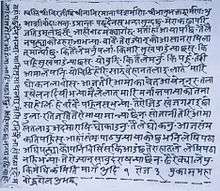Nara Nath Acharya
Pandit Kaviraj Nara Nath Acharya (Nepali:पण्डित कविराज नरनाथ आचार्य) (1906–1988) was the author of the Authentic (True) Biography of Bhanubhakta Acharya (1814–1868), first published in 1960.[1] The second edition of the book was published in 1979.[2] His biography of pioneer poet Bhanubhakta is the second most important after the one by Motiram Bhatta (1866-1896) the first biographer of Bhanubhakta. Naranath has tripled the information on the pioneer poet. He elaborated Bhanubhakta's works by publishing many of the poet's work for the first time and threw some new lights in the poet's life.[3] He had published the historical facsimile of Bhanubhakta's letters for the first time.[4] He was a grand nephew of Bhanubhakta Acharya. He was a Pandit (Sanskrit Scholar) and a Kaviraj (Ayurvedic physician) by profession.[5]
Pandit, Kaviraj Nara Nath Acharya | |
|---|---|
पण्डित कविराज नरनाथ अाचार्य | |
 Picture taken during 1975 | |
| Born | 1 April 1906 Tanahun,Nepal |
| Died | 7 May 1988 (82 years) Kathmandu , Nepal |
| Nationality | Nepali |
| Education | Bachelor's in Ayurveda |
| Occupation | Kaviraj (Ayurvedic Physician), Writer, Poet |
| Years active | 1926-1988 |
Notable work | Authentic(True) biography of Adikavi Bhanubhakta Acharya |
| Spouse(s) | Gangamaya Devi |
| Children | Bhojraj, Harimaya, Shivaraj, Sambaraj, Bishwaraj, Durgadevi, Jayaraj, Bijayaraj, Somraj |
| Parent(s) | Loka Nath Acharya (Father), Yashoda Devi (Mother) |
| Relatives | Bhanubhakta Acharya (Grand Uncle), Narahari Acharya (Nephew) |
Early Life
Naranath Acharya was born on April 1, 1906 while his father Lokanath Acharya (1870-1907) was far away in Taplejung in eastern Nepal working as a clerk in a government office but he died in Banaras where he had gone to bathe in the holy Ganges on the occasion of the first day of the month of Magh when the sun moves into the house of Capricorn that happened to be on a Monday with no moon and solar eclipse that year. There were pilgrims from all over India and the overcrowded city was filthy and Lokanath caught cholera and succumbed to it.
Naranath learned the alphabet from his older brother Umanath Acharya (1900-1960) and he began to memorize Amarakosha, the lexicon of Sanskrit in verse, even as he worked with his mother. Naranath went through the ceremony of Bratabandha on April 17, 1913. Then he started to read Candī(Sanskrit:चण्डी), Rudrī(Sanskrit:रुद्री) , Laghukaumudī (Sanskrit:लघु कौमुदी), Hitopadesha(Sanskrit:हितोपदेश), Raghuvamsha(Sanskrit: रघुवंश) and other books under the guidance of his uncle Bishwanath. He would run away from home to Kathmandu four days on foot to give the exams of his studies. Then in 1921 Naranath was selected to live in a hostel for free food and education at Tindhara Sanskrit Pathashala.
Marriage
Naranath got married at age 19 (on February 25, 1925) to Ganga Maya Devi (Wagley) who was just nine years old at that time. He continued to study and went to Banaras in February 1927 and passed the exam of Madhyamā (Intermediate) of Sanskrit Grammar. Then he went to Kathmandu to study Hindu astrology too. But then the government opened a primary school in Langdi, Sihrachowk Gorkha and he was interviewed and told that he would get a letter of appointment at home. But then his mother died just a few days before he could join his job. He could not continue teaching because of his poor health. He came back home and quit the job in December 1930.
Ayurvedic Physician
Naranath decided to study Ayurved in Kathmandu and graduated with a bachelor’s degree in 1931 and continued to study for the master’s degree (Acharya) in it. But early in 1933 the government decided to open an Ayurvedic dispensary in Bandipur, the district headquarters of Tanahu that was close to Naranath’s home, so he went to his posting in Bandipur on May 14, 1933. Then he was transferred to many places such as Tarkughat (1947), Myagdey (1950), Shyamgha (1952), Myagdey (1956), Manakamana (1959), Myagdey (1959), Japagadi, Palpa (1960) and Tuhure Pasal (1961). He retired in 1973. He died on April 7, 1988 at PashupatiAryaghat in Kathmandu.
Children
Naranath had seven sons: Bhoj Raj (1935-1953), Shiva Raj(1941-2017), Samba Raj (1943) Bishwa Raj (1945), Jaya Raj (1951), Bijaya Raj (1954) and Soma Raj (1957) and two daughters: Hari Maya Paudel (1938) and Durga Devi(1948-1957).
Works

His other published books are listed below.[6]
- Vadhu Rakshā (Nepali:वधूरक्षा) (In Defense of the Daughters-in-law), SatyaHarischandrakatha and Subhashitsangraha(Nepali:सत्य हरिश्चन्द्रकथा तथा सुभाषितसंग्रह ) (In a single book, 1959)
- Ādikavi Kavisamrat Bhānubhakta Ācāryako saccā jı̄vanacarittra (Nepali:आदिकवि कविसम्राट् भासनुभक्त आचार्यको सच्चा जीवनचरित्र)(First Edition 1960, Second Edition 1979)
- Lakshahom Yajyako Varnan (1961)(Nepali:लक्षहोम यज्ञको वर्णन)
- Lakshahuti Pancadasi(Sanskrit:लक्षाहुतिपञ्चदशी ) (First and Second, 1976)
- Ādikavi Bhānubhakta Ācāryako saccā jı̄vanacarittra-Second Edition-1979(Nepaliआदिकवि भानुभक्त आचार्यको सच्चा जीवनचरित्र (द्वितीय संस्करण, वि. सं. २०३६)
- Kavita Sangraha (Collections of Poems)(Nepali:कविता संग्रह)1983
- Padyamālā (Garland of Verses)(Collections of Poems)(Nepali:पद्यमाला) 1983
- Caturasitipujavidhih (Sanskrit:चतुरशीतिपूजाविधि )(Ritual methods for celebrating 84 years, Published posthumously in 2006)
References
- Subedi, Abhi Nepali Literature: Background & History p211, Sajha Prakashan, 1978
- Acharya, Pandit Kaviraj Nara Nath Adikavi Bhanubhakta Acharyako Sacca Jivancaritra Archived 24 September 2016 at the Wayback Machine 1979
- Pradhan, Kumar A History of Nepali Literature p217, Sahitya Academy, 1984
- Pradhan, Parasmani Adikavi Bhanubhakta Acharya p26, Bhagya Laxmi Prakashan, 1979
- Dhakal, Yashoda Nara Nath Acharyako Jivani, Vyaktitva Ra Krititvako Adhyayan, Masters Thesis in Nepali of Tribhuvan University
- Acharya, Pandit Kaviraj Naranath Sharma, Chaturashitipujapaddhatih, Svaddhyayashala 2006
External links
- Āchārya, Naranātha; Śivarāja Āchārya; Sāmbarāja Āchārya; Jayaraj Acharya (1979). Ādikavi Bhānubhakta Ācāryako saccā jı̄vanacarittra. Kathmandu: Naranātha Āchārya. OCLC 10023122.
- Voice of Naranath Acharya